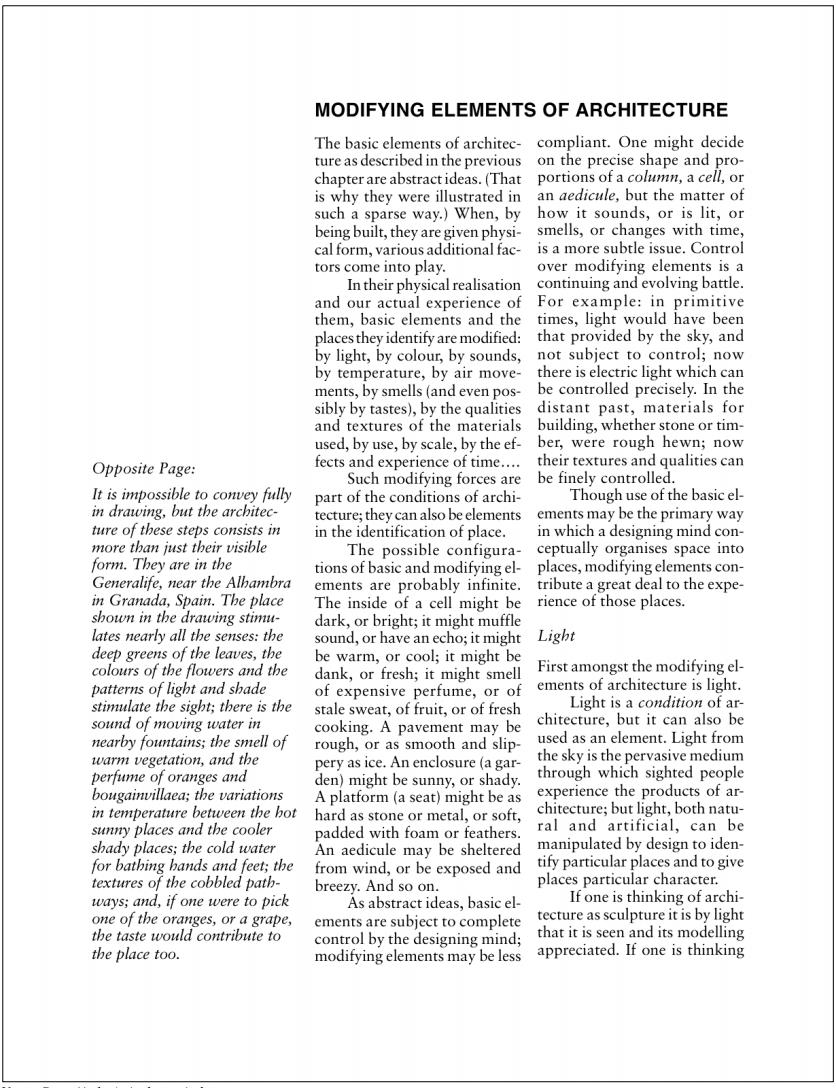
MODIFYING ELEMENTS OF ARCHITECTURE The basic elements of architec-compliant.One might decide ture as described in the previous on the precise shape and pro- chapter are abstract ideas.(That portions of a column,a cell,or is why they were illustrated in an aedicule,but the matter of such a sparse way.)When,by how it sounds,or is lit,or being built,they are given physi-smells,or changes with time, cal form,various additional fac-is a more subtle issue.Control tors come into play. over modifying elements is a In their physical realisation continuing and evolving battle. and our actual experience of For example:in primitive them,basic elements and the times,light would have been placesthey identify are modified:that provided by the sky,and by light,by colour,by sounds,not subject to control;now by temperature,by air move- there is electric light which can ments,by smells (and even pos- be controlled precisely.In the sibly by tastes),by the qualities distant past,materials for and textures of the materials building,whether stone or tim- used,by use,by scale,by the ef-ber,were rough hewn;now Opposite Page: fects and experience of time.... their textures and qualities can Such modifying forces are be finely controlled. It is impossible to convey fulby part of the conditions of archi- Though use of the basic el- in drawing,but the architec- tecture;they can also be elements ements may be the primary way ture of these steps consists in in the identification of place. in which a designing mind con- more than just their visible The possible configura- ceptually organises space into form.They are in the tions of basic and modifying el- places,modifying elements con- Generalife,near the Albambra ements are probably infinite. tribute a great deal to the expe- in Granada,Spain.The place The inside of a cell might be rience of those places. shown in the drawing stimu- dark,or bright;it might muffle lates nearly all the senses:the sound,or have an echo;it might Light deep greens of the leaves,the be warm,or cool;it might be colours of the flowers and the dank,or fresh;it might smell First amongst the modifying el- patterns of light and shade of expensive perfume,or of ements of architecture is light. stimulate the sight;there is the stale sweat,of fruit,or of fresh Light is a condition of ar- sound of moving water in cooking.A pavement may be chitecture,but it can also be nearby fountains;the smell of rough,or as smooth and slip- used as an element.Light from warm vegetation,and the pery as ice.An enclosure (a gar- the sky is the pervasive medium perfume of oranges and den)might be sunny,or shady. through which sighted people bougainillaea;the variations A platform (a seat)might be as experience the products of ar- in temperature between the hot hard as stone or metal,or soft, chitecture;but light,both natu- sunny places and the cooler padded with foam or feathers. ral and artificial,can be shady places;the cold water An aedicule may be sheltered manipulated by design to iden- for bathing hands and feet;the from wind,or be exposed and tify particular places and to give textures of the cobbled path- breezy.And so on. places particular character. ways;and,if one were to pick As abstract ideas,basic el- If one is thinking of archi- one of the oranges,or a grape, ements are subject to complete tecture as sculpture it is by light the taste would contribute to control by the designing mind; that it is seen and its modelling the place too. modifying elements may be less appreciated.If one is thinking
Copyright ?1997. Routledge. All rights reserved. May not be reproduced in any form without permission from the publisher, except fair uses permitted under U.S. or applicable copyright law. Unwin, Simon(Author). Analysing Architecture. London, UK: Routledge, 1997. p 25. http://site.ebrary.com/lib/sjtu/Doc?id=10057283&ppg=26
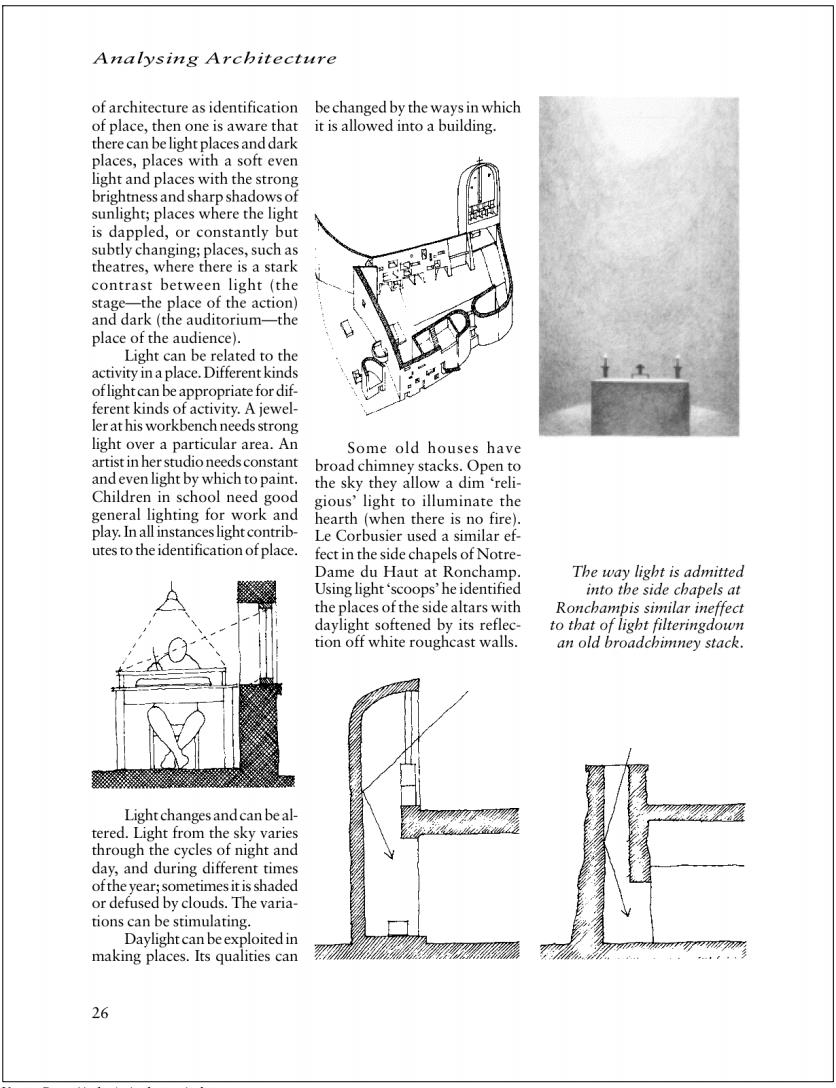
Analysing Architecture of architecture as identification be changed by the ways in which of place,then one is aware that it is allowed into a building. there can be light places and dark places,places with a soft even light and places with the strong brightness and sharp shadows of sunlight;places where the light is dappled,or constantly but subtly changing;places,such as theatres,where there is a stark contrast between light (the stage-the place of the action) and dark(the auditorium-the place of the audience). Light can be related to the activity in a place.Different kinds oflight can be appropriate for dif- ferent kinds of activity.A jewel- ler at his workbench needs strong light over a particular area.An Some old houses have artist in her studio needs constant broad chimney stacks.Open to and even light by which to paint. the sky they allow a dim 'reli- Children in school need good gious'light to illuminate the general lighting for work and hearth (when there is no fire). play.In all instances light contrib- Le Corbusier used a similar ef- utes to the identification of place. fect in the side chapels of Notre- Dame du Haut at Ronchamp. The way light is admitted Using light'scoops'he identified into the side chapels at the places of the side altars with Ronchampis similar ineffect daylight softened by its reflec- to that of light filteringdown tion off white roughcast walls. an old broadchimney stack. Light changes and can be al- tered.Light from the sky varies through the cycles of night and day,and during different times of the year;sometimes it is shaded or defused by clouds.The varia- tions can be stimulating. Daylight can be exploited in making places.Its qualities can 26
Copyright ?1997. Routledge. All rights reserved. May not be reproduced in any form without permission from the publisher, except fair uses permitted under U.S. or applicable copyright law. Unwin, Simon(Author). Analysing Architecture. London, UK: Routledge, 1997. p 26. http://site.ebrary.com/lib/sjtu/Doc?id=10057283&ppg=27
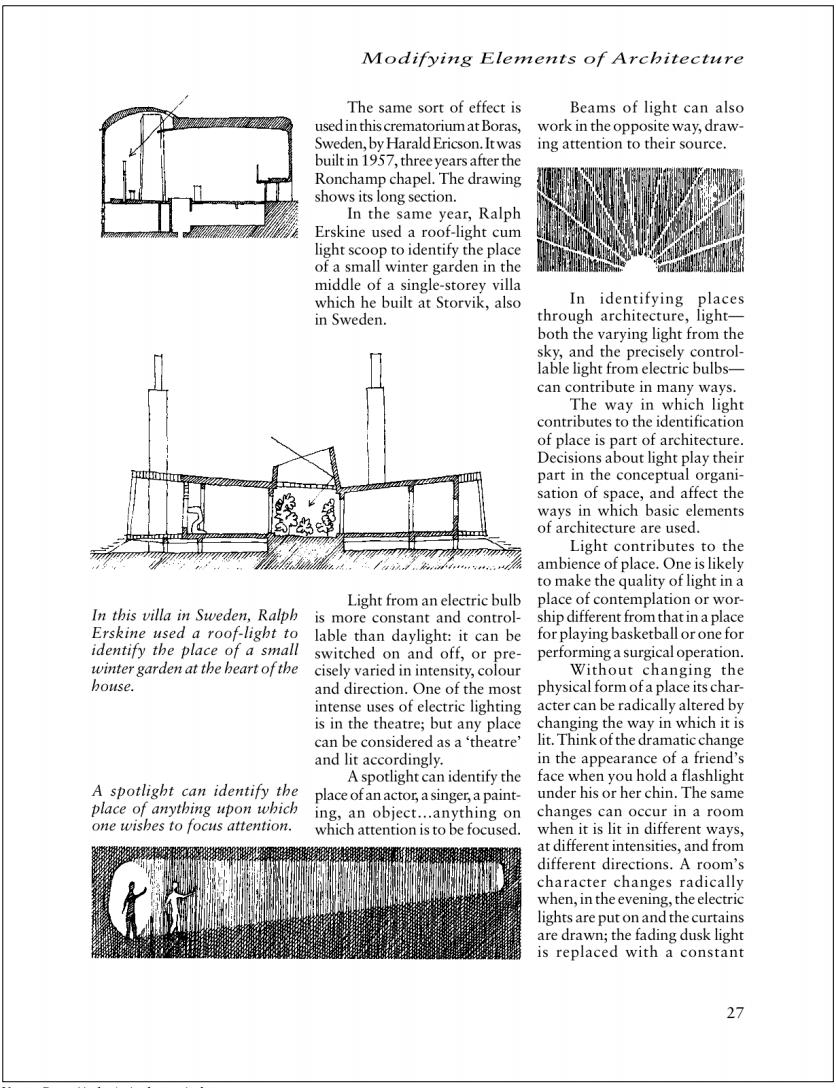
Modifying Elements of Architecture The same sort of effect is Beams of light can also used in this crematorium at Boras, work in the opposite way,draw- Sweden,by Harald Ericson.It was ing attention to their source. built in 1957,three years after the Ronchamp chapel.The drawing shows its long section. In the same year,Ralph Erskine used a roof-light cum light scoop to identify the place of a small winter garden in the middle of a single-storey villa which he built at Storvik,also In identifying places in Sweden. through architecture, light- both the varying light from the sky,and the precisely control- lable light from electric bulbs- can contribute in many ways. The way in which light contributes to the identification of place is part of architecture. Decisions about light play their part in the conceptual organi- sation of space,and affect the ways in which basic elements of architecture are used. Light contributes to the ambience of place.One is likely to make the quality of light in a Light from an electric bulb place of contemplation or wor- In this villa in Sweden,Ralph is more constant and control- ship different from that in a place Erskine used a roof-light to lable than daylight:it can be for playing basketball or one for identify the place of a small switched on and off,or pre- performing a surgical operation. winter garden at the beart of the cisely varied in intensity,colour Without changing the house. and direction.One of the most physical form of a place its char- intense uses of electric lighting acter can be radically altered by is in the theatre;but any place changing the way in which it is can be considered as a'theatre' lit.Think of the dramatic change and lit accordingly. in the appearance of a friend's A spotlight can identify the face when you hold a flashlight A spotlight can identify the place of an actor,a singer,a paint- under his or her chin.The same place of anything upon which ing,an object...anything on changes can occur in a room one wishes to focus attention. which attention is to be focused. when it is lit in different ways, at different intensities,and from different directions.A room's character changes radically when,in the evening,the electric lights are put on and the curtains are drawn;the fading dusk light is replaced with a constant 27
Copyright ?1997. Routledge. All rights reserved. May not be reproduced in any form without permission from the publisher, except fair uses permitted under U.S. or applicable copyright law. Unwin, Simon(Author). Analysing Architecture. London, UK: Routledge, 1997. p 27. http://site.ebrary.com/lib/sjtu/Doc?id=10057283&ppg=28
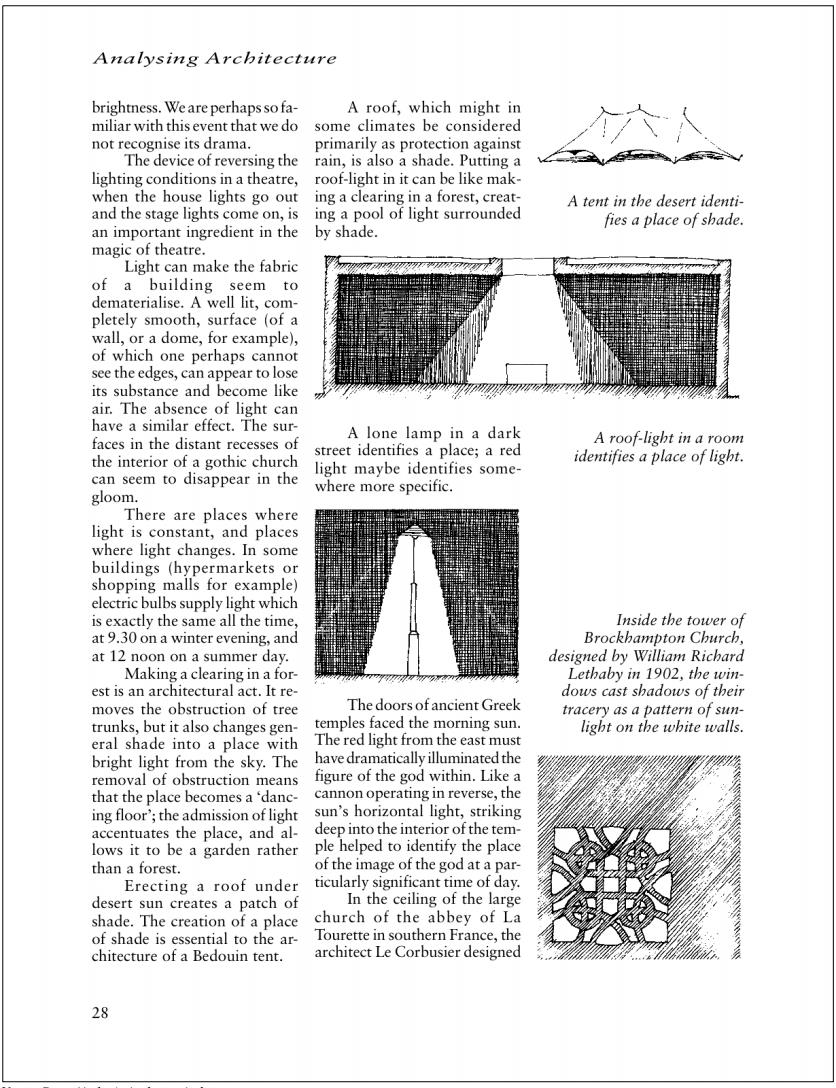
Analysing Architecture brightness.We are perhaps so fa- A roof,which might in miliar with this event that we do some climates be considered not recognise its drama. primarily as protection against 六人 The device of reversing the rain,is also a shade.Putting a lighting conditions in a theatre, roof-light in it can be like mak- when the house lights go out ing a clearing in a forest,creat- A tent in the desert identi- and the stage lights come on,is ing a pool of light surrounded fies a place of shade. an important ingredient in the by shade. magic of theatre. Light can make the fabric of a building seem to dematerialise.A well lit,com- pletely smooth,surface (of a wall,or a dome,for example), of which one perhaps cannot see the edges,can appear to lose its substance and become like air.The absence of light can have a similar effect.The sur- A lone lamp in a dark faces in the distant recesses of A roof-light in a room street identifies a place;a red the interior of a gothic church identifies a place of light. light maybe identifies some- can seem to disappear in the where more specific. gloom. There are places where light is constant,and places where light changes.In some buildings (hypermarkets or shopping malls for example) electric bulbs supply light which is exactly the same all the time Inside the tower of at 9.30 on a winter evening,and Brockhampton Church, at 12 noon on a summer day. designed by William Richard Making a clearing in a for- Lethaby in 1902,the win- est is an architectural act.It re- dows cast shadows of their moves the obstruction of tree The doors of ancient Greek tracery as a pattern of sun- trunks,but it also changes gen- temples faced the morning sun. ligbt on the white walls. eral shade into a place with The red light from the east must bright light from the sky.The have dramatically illuminated the removal of obstruction means figure of the god within.Like a that the place becomes a'danc- cannon operating in reverse,the ing floor';the admission of light sun's horizontal light,striking accentuates the place,and al- deep into the interior of the tem- lows it to be a garden rather ple helped to identify the place than a forest. of the image of the god at a par- Erecting a roof under ticularly significant time of day. desert sun creates a patch of In the ceiling of the large shade.The creation of a place church of the abbey of La of shade is essential to the ar- Tourette in southern France,the chitecture of a Bedouin tent. architect Le Corbusier designed 28
Copyright ?1997. Routledge. All rights reserved. May not be reproduced in any form without permission from the publisher, except fair uses permitted under U.S. or applicable copyright law. Unwin, Simon(Author). Analysing Architecture. London, UK: Routledge, 1997. p 28. http://site.ebrary.com/lib/sjtu/Doc?id=10057283&ppg=29
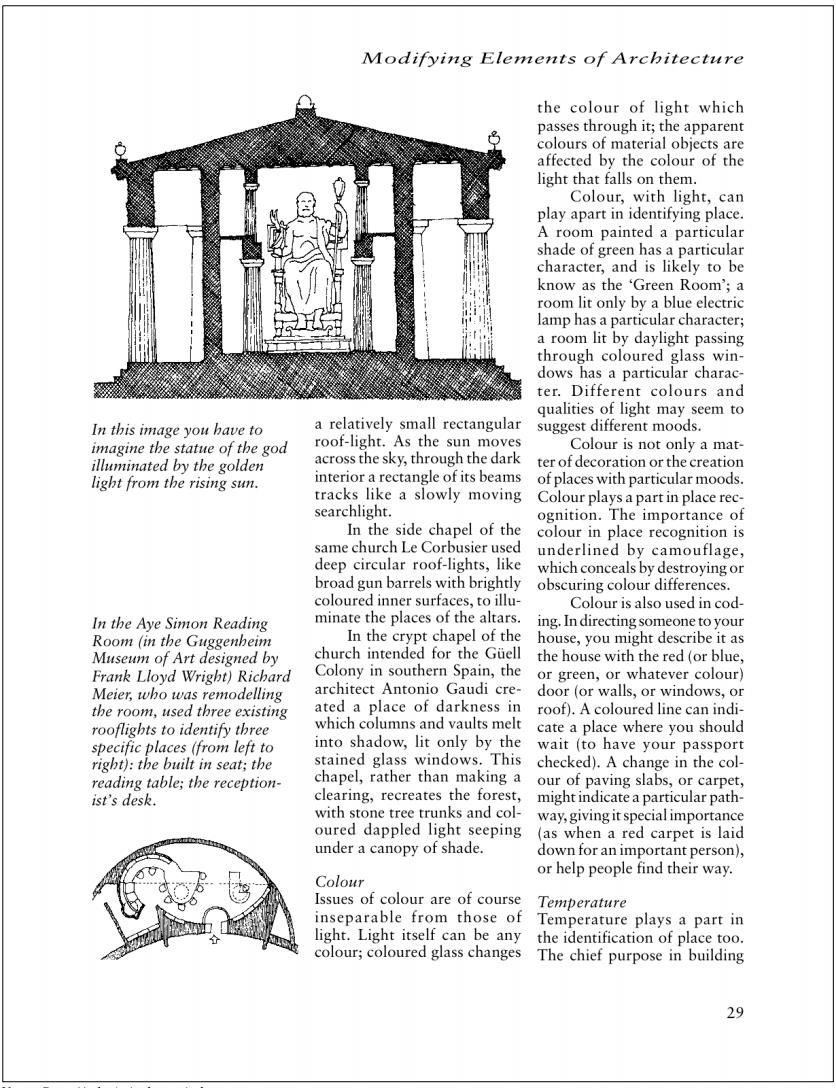
Modifying Elements of Architecture the colour of light which passes through it;the apparent colours of material objects are affected by the colour of the light that falls on them. Colour,with light,can play apart in identifying place. A room painted a particular shade of green has a particular character,and is likely to be know as the 'Green Room';a room lit only by a blue electric lamp has a particular character; a room lit by daylight passing through coloured glass win- dows has a particular charac- ter.Different colours and qualities of light may seem to In this image you have to a relatively small rectangular suggest different moods. imagine the statue of the god roof-light.As the sun moves Colour is not only a mat- illuminated by the golden across the sky,through the dark ter of decoration or the creation light from the rising sun. interior a rectangle of its beams of places with particular moods. tracks like a slowly moving Colour plays a part in place rec- searchlight. ognition.The importance of In the side chapel of the colour in place recognition is same church Le Corbusier used underlined by camouflage, deep circular roof-lights,like which conceals by destroying or broad gun barrels with brightly obscuring colour differences. coloured inner surfaces,to illu- Colour is also used in cod- In the Aye Simon Reading minate the places of the altars. ing.In directing someone to your Room (in the Guggenheim In the crypt chapel of the house,you might describe it as Museum of Art designed by church intended for the Guell the house with the red (or blue, Frank Lloyd Wright)Richard Colony in southern Spain,the or green,or whatever colour) Meier,who was remodelling architect Antonio Gaudi cre-door (or walls,or windows,or the room,used three existing ated a place of darkness in roof).A coloured line can indi- rooflights to identify three which columns and vaults melt cate a place where you should specific places (from left to into shadow,lit only by the wait(to have your passport right):the built in seat;the stained glass windows.This checked).A change in the col- reading table;the reception- chapel,rather than making a our of paving slabs,or carpet, ist's desk. clearing,recreates the forest,might indicate a particular path- with stone tree trunks and col-way,giving it specialimportance oured dappled light seeping (as when a red carpet is laid under a canopy of shade. down for an important person), or help people find their way. Colour Issues of colour are of course Temperature inseparable from those of Temperature plays a part in light.Light itself can be any the identification of place too. colour;coloured glass changes The chief purpose in building 29
Copyright ?1997. Routledge. All rights reserved. May not be reproduced in any form without permission from the publisher, except fair uses permitted under U.S. or applicable copyright law. Unwin, Simon(Author). Analysing Architecture. London, UK: Routledge, 1997. p 29. http://site.ebrary.com/lib/sjtu/Doc?id=10057283&ppg=30